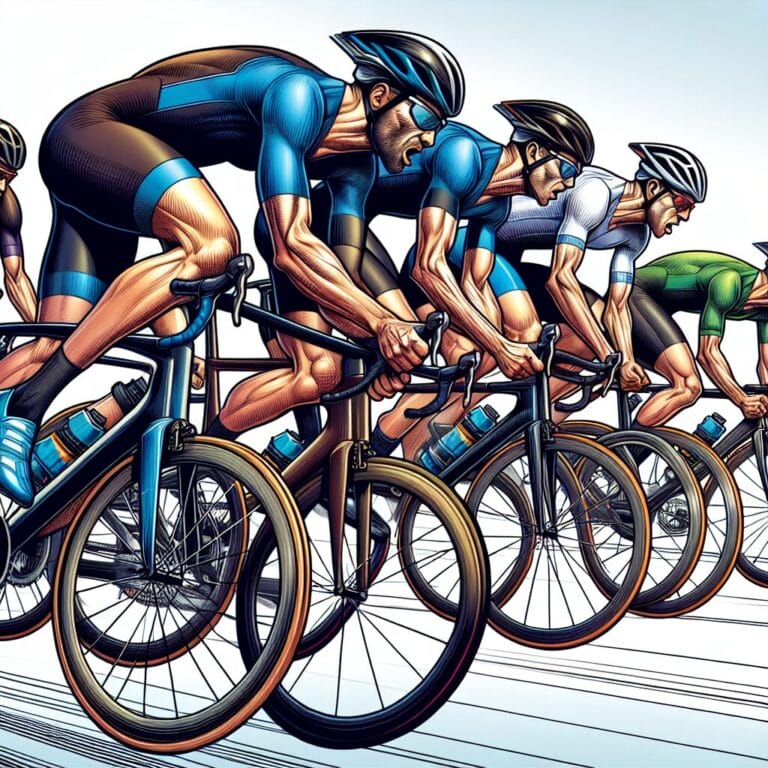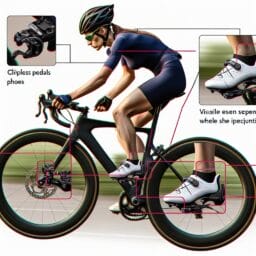
Maximizing Performance: Training and Nutrition Tips for the Competitive Cyclist
Table of Contents
- Introduction
- Training Strategies for Competitive Cyclists
- Nutritional Guidelines for Peak Performance
- Supplements and Ergogenic Aids
- The Mental Aspect of Competitive Cycling
- Conclusion
- Frequently Asked Questions
Introduction
Hey there, cycling fans! Did you know that bike technology is like the secret sauce in the world of elite cycling? Yup, it’s not just about those leg muscles; it’s also about riding smart. For all you road cyclists and track stars aiming for the main peloton or dreaming of acing the track cycling omnium, listen up! Optimizing your training isn’t only about racking up miles and pushing pedals harder. It’s also about finding that sweet spot – what pros call the “minimum effective dose” of training stress to boost your performance.
Now, let’s chat nutrition because that fuel you put in your tank matters big time. Think about this: What if I said munching on certain foods at specific times could turn you into a high-speed cycling machine? We’re talking carbs to keep you going during those long rides and protein to repair and build muscle after strength training. Plus, don’t forget those unsung heroes like omega-3s for recovery and beets for endurance – yes, beets!
And here’s something else – even elite athletes need rest days. Rest doesn’t mean you kick back with loads of donuts (tempting, I know); it means letting your body heal so that all the hard work pays off. Remember folks, whether you’re a master cyclist or a junior champ, optimizing your riding hours with smart bike training can definitely improve how fast and far you go. So gear up for an adventure in cycling disciplines as we dive deep into making every pedal count without leaving out a bit of fun! 🚴💨

Training Strategies for Competitive Cyclists
Guess what? Every cyclist’s body is like a unique puzzle, with pieces that fit together in their own special way. That means your training plan should be as one-of-a-kind as you are! Elite cyclists and peppy pedal pushers alike can see a world of difference when they tailor-make their workout plans. It’s about matching the right mix of endurance rides, where you cruise at a steady beat to build up that staying power; speed work through interval training, which gets your heart racing and muscles firing; and the magic of cross-training effects—think swimming or even yoga—to keep those limbs limber and ready for anything.
Now, imagine you’re on a treasure hunt – but instead of gold, you’re after gains in sports performance. How do you know if you’re on the right path? Metrics! The same way USA Cycling tracks progress for team performance, individual cyclists can use tools like heart rate monitors to check if their ticker is ticking just right during training. Keep tabs on average speed to watch it soar over time. And sure enough, those numbers will whisper (or sometimes shout) when it’s time to shake things up with more intensity or volume.
But hang on, let’s not forget the potential benefits lurking in what might seem like unlikely places. Masters athletes—that’s code for older sports heroes—and younger guns alike can find common ground through mental focus drills that fire up the brain’s connection to those cycling muscles. Mix in visualization techniques and mindfulness practices alongside your bike training to improve both pedal power and inner calm.
And who said all this hard work doesn’t come with perks? Turns out, off-the-bike adventures like rock climbing or dancing could actually boost your cycling performance too! These activities aren’t just fun detours; they help build overall strength and coordination essential for those high-speed sprints towards the finish line or maintaining high speeds over longer distances especially during competitive season.
So there you have it: crafting your personal road map for cycling success involves so much more than just logging miles on two wheels. It’s about smartly pushing limits with varied workouts, keeping an eagle eye on progress indicators, using rest days wisely (because yes, they count too!), and mixing in some unexpected but super helpful cross-training escapades. Ready to ride into new realms of fitness glory? Let’s make every session count—onward to victory! 🚵♀️🌟

Nutritional Guidelines for Peak Performance
When it comes to fueling the ride, cyclists need a trifecta of macronutrients: carbohydrates, proteins, and fats. It’s like planning the perfect party plate; except this one is for your muscles! Carbs are the life of the party, giving you that quick energy to keep pedaling strong. Think of them as your body’s go-to dance partner for endurance athletes and high-speed cycling. Protein steps in like a rock-solid friend helping to repair and rebuild muscle after those intense training sessions. And let’s not leave out fats – they’re like the cool DJ spinning long-lasting energy tunes for those longer rides.
Hydration can be like navigating through a desert on two wheels – you’ve got to get it just right to survive the trek! Elite cyclists know that managing their water intake isn’t just about avoiding thirst; it’s about maintaining a delicate balance of fluids and electrolytes. Zap those cramps and fatigue by sipping on electrolyte-infused drinks before, during, and after competitive cycling events or even just tough training days.
Timing your nutrient intake is pretty much as important as nailing that perfect gear shift while riding. Gobble up some easily digestible carbs before you start pedaling to fill up your energy reserves. Mid-ride munchies? A banana or an energy bar can do wonders without weighing you down. And when you cross that finish line or wrap up a rigorous training session, refuel within 30 minutes with a mix of carbs and protein to kickstart recovery.
Remember how Cinderella turned into a princess at just the right moment? That’s kind of what happens when you nail your meal timing – except instead of getting a fancy dress, cyclists boost their chances of becoming part of that main peloton or even standing atop the podium at track cycling omniums.
So there we have it, folks! Whether you’re an elite level cyclist aiming for pro status or a weekend warrior hitting the pavement for fun, understanding these nutritional nuggets can seriously improve performance. Mix these strategies with smart bike technology use during riding hours and well-planned rest days (no sneaky donuts!), and you’ll be well on your way to out-peddling competitors come next competitive season! 🚴♂️🏆💦
Supplements and Ergogenic Aids
Pedaling into the world of elite cycling, did you know there’s a trove of legal supplements that could give cyclists an extra push? Picture this: multivitamins acting like tiny cheerleaders, boosting overall health so riders can train harder and recover faster. And then there are specific stars of the supplement show—like creatine for that explosive power during high-speed cycling sprints or beta-alanine to buffer those burning muscles when competitive intensity hits the roof.
But before you rush to stock your pantry, let’s dive into the buzz around ergogenic aids. These are fancy agents designed to enhance sports performance, often walking a fine line between giving an edge and raising eyebrows in terms of fairness. It’s a hot topic where professional road cycling meets ethical debates head-on. While every pedal stroke can be a step towards victory, elite cyclists must weigh the potential benefits against possible risks. Could these supplements cause harm down the road? Are they turning the spirit of sport into just another race for who has the fanciest fuel?
Now imagine a roundtable where masters athletes and fresh-faced pros discuss their experiences with these aids; some swear by them while others stick to whole foods and pure grit. The talk turns to omega-3s for heart health, caffeine for alertness on long endurance rides, and even beetroot juice for that oxygen boost at critical moments. Masters cyclists, often older athletes with years of bike training under their belts, might find particular interest in joint-supporting compounds due to their physiological characteristics.
With each discussion about optimizing cycling training and nutrition comes a reminder: it’s not just about popping pills but rather improving performance holistically—combining strength training smarts with a dash of science in supplement form. Whether aiming for the main peloton or setting sights on track cycling omnium glory, individual cyclists should consult with health pros before revamping their training nutrition playbook.
So as riders zip through various cycling disciplines this competitive season—from endurance athletes tackling road races to power athletes owning track events—the blend of proper rest days, mental focus drills, tailored bike technology use during riding hours, and yes—even supplemental support—could very well dictate who stands atop that podium! 🚴♀️💊🏅
The Mental Aspect of Competitive Cycling
Rolling through the winding roads of professional road cycling or sprinting around a track cycling circuit demands more than just physical grit; it requires a sharp, focused mind too. Elite cyclists invest in training not only their muscles but also their minds. Mental toughness, the kind that lets you push through pain and fatigue when your legs scream “no more,” can often be the difference between who wears the yellow jersey and who doesn’t.
Rest days don’t just soothe tired muscles; they’re essential for mental recovery as well. It’s during these quieter moments away from riding hours and high speeds that an athlete’s brain consolidates skills learned and rejuvenates for the next bout of competitive intensity. Sleep is the secret weapon here—think of it as your brain going into its own little repair shop every night. During deep sleep, neuronal connections are strengthened, ensuring all those new strategies from bike technology to pacing tactics stay firmly lodged in your memory banks.
But how do individual cyclists foster this crucial mental focus? Let’s wheel out some psychological strategy must-haves:
– Set bite-sized goals: Breaking down the long road to elite level cycling into manageable chunks makes progress seem achievable.
– Visualize success: Close those eyes and see yourself gliding across a finish line or mastering a tough climb—it tells your brain that yes, you can do this!
– Breathing exercises: Take slow, deep breaths to calm pre-race jitters or mid-training anxieties.
– Positive self-talk: Replace “I can’t” with “I will”—self-belief is fuel for sports performance engines.
Elite cyclists, from road warriors to masters athletes (those older champs with stories to tell), rely on such techniques to keep their mental focus laser-sharp. And when physiological characteristics change—as they do with our masterful older athletes—adapting mental strategies becomes even more vital.
Here’s something else neat about rest days—they give team performance a boost by encouraging bonding over shared experiences off-bike which strengthens group cohesion come race day.
So whether you’re aiming for personal glory in individual time trials or working together with USA Cycling teammates, remember that cycling disciplines aren’t solely won with leg power. The mind needs its training regime too—a cocktail of resilience-building practices and quality downtime—to improve performance levels across kilometers of competitive season battles. Riding towards victory isn’t just about physical might; it’s also about mastering the mental marathon! 🚴♂️🧠✨
| Aspect | Importance | Techniques |
|---|---|---|
| Mental Toughness | Essential for pushing through pain and fatigue | Positive self-talk, visualization |
| Rest Days | Allow mental recovery and skill consolidation | Quality downtime, rest from physical activity |
| Sleep | Strengthens neuronal connections, aids memory | Ensure adequate deep sleep |
| Goal Setting | Makes progress achievable | Set bite-sized, manageable goals |
| Visualization | Strengthens belief in abilities | Imagine success and mastery over challenges |
| Breathing Exercises | Calms pre-race jitters and anxieties | Slow, deep breathing techniques |
| Positive Self-Talk | Boosts self-belief and mental resilience | Replace negative thoughts with affirmations |
| Team Bonding | Enhances team performance and cohesion | Shared experiences and interactions off-bike |
| Adapting Strategies | Important as physiological characteristics change | Adjust mental techniques to suit individual needs |
Conclusion
Roll into the world of cycling where your next snack or sprint could be a game changer! In elite cycling, it’s not just about pedaling faster or longer; it’s about pedaling smarter. To rocket past competitors on the road or track, cyclists need to fine-tune their bodies like high-performance engines, carefully calibrated for each twist and turn of their racing journey.
Here’s something you might not know: Even bike technology gets an upgrade when fueled by top-notch training nutrition. Just as race cars need premium gasoline, cyclists’ chances of leading the main peloton surge when they power up with the right nutrients. Elite level cyclists become savvy chefs in their own kitchens, whipping up meals that are equal parts delicious and beneficial for their rigorous training schedules.
Now, consider heart rate—the drummer in your body’s band—it sets the pace for how hard and fast you go. By syncing training volume with this personal beat, individual cyclists can achieve what experts call ‘minimum effective dose’—that perfect amount of training stress without overdoing it. This approach helps maintain a steady average speed and ensures riders aren’t left gasping for air at crucial moments during a competitive season.
Masters athletes show us that age isn’t just a number but an opportunity to adapt skills to evolving physiological characteristics. They’re proof that mental focus and smart bike training improve performance levels across all ages. Masters cyclists might take strength training slow but they sure pack a punch when it counts!
When we talk about rest days, we’re giving a big high-five to recovery. These aren’t lazy days; they’re strategic pit stops ensuring both older athletes and young guns alike can stay sharp mentally and physically. Team performance thrives when everyone brings their A-game refreshed after some well-deserved downtime.
So pedal pushers from every corner—whether you dream of dominating professional road cycling arenas or love feeling like a power athlete on local tracks—embrace that delicate balance between pushing pedals and munching on powerhouse foods. With every ride and bite, challenge yourself to inch closer to personal goals while relishing the joy of cycling disciplines. And hey, who knows? Maybe one day soon you’ll find yourself speeding toward victory because you played your cards right on every front: from endurance athletes’ stamina secrets to sports performance wisdom shared among comrades on two wheels! 🚴♂️🌟🍽️



